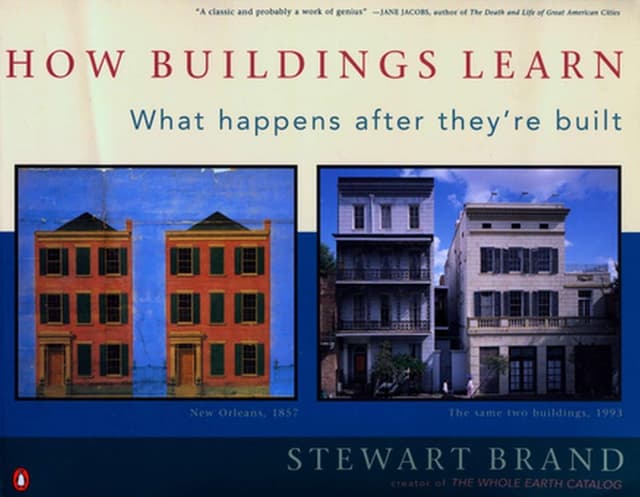Noah Brier | March 3, 2021
The Pace Layers Edition
On time, culture, and shearing layers
Recommended Products

Brand adapted Frank Duffy's work into a kind of proto-pace layer framework, expanding it to six S's and noting that 'Because of the different rates of change of its components, a building is always tearing itself apart.'
Noah here. A popular trope of modern life is that everything is moving faster. And while that’s certainly true for many things, I also think people’s view of that speed is often clouded by their own nostalgia for the past. One lens I’ve put on change is to try to find things that have grown an order of magnitude over a time period to understand just how drastic the shift has been. Disposable income in China has grown an order of magnitude since the 1980s, for instance, but the number of SKUs in a supermarket hasn’t (it has gone from just under 20k to nearly 50k).
With that said, there are certainly many things that are fundamentally moving faster today, especially when it comes to culture. Here’s how Simon DeDeo, who studies cultural evolution through the data those cultures produced, put it on a recent podcast (lightly edited for readability):
Before the internet, the speed of culture was weeks and months. You and I, we're chatting right now, it's real-time, it's live. But the average person who didn't have his own AM radio show could write a letter to the newspaper, or maybe write a book, maybe make a speech at a rally. That clock was ticking once a week, once a month. … Now, a person you pick at random can engage with the larger culture in seconds. Almost as fast as they can process it visually. … What that does is it just speeds everything up by this factor. And you calculate it, maybe it's 40,000. If you think that culture has accelerated like that, you just do that naive calculation. If we had sped up biological evolution by the same amount, we would get from the chimpanzee to the humans in 100 years, something like that, right? Culture is moving so much faster, that we actually have no idea what's going to happen. It's difficult to study because as soon as you scrape the archive, new stuff comes up.
Why is this interesting?
While the specifics of our current speed and cultural outputs may be different, people have been grappling with how to think about this kind of change for a long time. One of my favorite models in this sphere comes from Stewart Brand in the form of his Pace Layers model. The inspiration for the framework came from an architect named Frank Duffy who encouraged builders not to think of a building as a single entity, but as a set of “shearing layers” operating at different timescales: Shell, services, scenery, and sets.
Brand picked up on Duffy’s work and adapted it to a kind of proto-pace layer framework in his 1994 book How Buildings Learn: What Happens After They’re Built, expanding it to six S’s and noting that “Because of the different rates of change of its components, a building is always tearing itself apart.”
Finally, shearing layers transformed into a broader view on how society functions in the form of Brand’s pace layers diagram. The outer layers—fashion and commerce—move fastest while the inner layers of nature and culture move much more slowly. Because they’re all moving at different speeds, the system is better able to react to shocks. “Some parts respond quickly to the shock,” Brand wrote, “allowing slower parts to ignore the shock and maintain their steady duties of system continuity.” Last year I wrote a bit about COVID managed to break this model by cutting the layers vertically by tapping into our systems of transmission.
While we talk about culture in the form of movies and TV shows, mostly that stuff exists on the level of fashion and commerce: meant to move quickly and absorb shocks. As Brand puts it, fashion’s sole job is to change. “It is culture cut free to experiment as creatively and irresponsibly as the society can bear.” But where real challenges start to emerge is when either you get serious shocks to slow-moving systems—think of an earthquake that literally forms a crack upward through the layers—or when two adjacent layers begin moving at such different speeds that one begins to peel off the other. It’s hard not to think we’re feeling some of that between commerce and infrastructure and governance and culture at the moment. (NRB)
Tip of the Day:
How to use that old iMac as a monitor. (CJN)
Quick Links:
Good Slides Reduce Complexity. Good deck-building tips from Tom Crichlow. (NRB)
A collection of essential Andy Weatherall mixes (CJN)
A Nike scandal focused on an executive’s son and rare sneakers (CJN)
Thanks for reading,
Noah (NRB) & Colin (CJN)
—
Why is this interesting? is a daily email from Noah Brier & Colin Nagy (and friends!) about interesting things. If you’ve enjoyed this edition, please consider forwarding it to a friend. If you’re reading it for the first time, consider subscribing (it’s free!).



